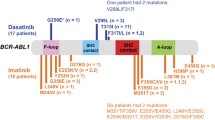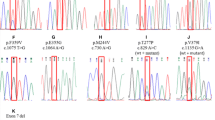Abstract
To explore the characteristics of BCR–ABL kinase domain point mutations in Chinese chronic myeloid leukemia (CML) patients, a cohort of 127 patients with hematologic or cytogenetic resistance to imatinib are screened by direct sequencing. Mutations are found in 74 patients (58%). More patients with hematologic resistance show mutations compared to patients with cytogenetic resistance (70% vs 44%, p = 0.002), and more patients with acquired resistance present mutations compared to patients with primary resistance (68% vs 48%, p = 0.031). Frequencies of mutations were similar in early chronic phase (ECP), late chronic phase (LCP), accelerated phase, and blast phase (BP) patients (56%, 58%, 50%, and 69%, respectively; p > 0.05). Overall, 25 mutants are found in 21 amino acid sites, and four of them (I418V, E450A, E453L, and E455K) are first reported here. All patients with these four mutants either progress to or reenter the BP. The most frequent mutant is M244V, followed by Y253H, F359C/V/I, G250E, E255K, and T315I. Only seven patients (9%) have T315I mutants, and all showed hematologic resistance. Three of them were in the ECP and three in the LCP. Look-back studies show that mutants were detected 0–20 (median 7) months ahead of the appearance of clinical resistance in 15 tested patients with acquired resistance. ABL mutations are common in Chinese imatinib-resistant CML patients and are associated with clinical resistance. Chinese patients also seem to have unique profiles in the types and frequencies of some mutants, the disease phases of patients with T315I mutation, and the frequency of mutations in CP patients.
Similar content being viewed by others
References
Kantarjian H, Sawyers C, Hochhaus A, Guilhot F, Schiffer C, Gambacorti-Passerini C et al (2002) Hematologic and cytogenetic responses to imatinib mesylate in chronic myelogenous leukemia. N Engl J Med 346:645–652
O’Brien S, Guilhot F, Larson RA, Gathmann I, Baccarani M, Cervantes F et al (2003) Imatinib compared with interferon and low-dose cytarabine for newly diagnosed chronic-phase chronic myeloid leukemia. N Engl J Med 348:994–1004
Branford S, Rudzki Z, Harper A, Grigg A, Taylor K, Durrant S et al (2003) Imatinib produces significantly superior molecular responses compared to interferon alfa plus cytarabine in patients with newly diagnosed chronic myeloid leukemia in chronic phase. Leukemia 17:2401–2409
Lahaye T, Riehm B, Berger U, Paschka P, Muller P, Kreil S et al (2005) Response and resistance in 300 patients with BCR–ABL positive leukemias treated with imatinib in a single center: a 4.5-year follow-up. Cancer 103:1659–1669
Sawyers CL, Hochhaus A, Feldman E, Goldman JM, Miller CB, Ottmann OG et al (2002) Imatinib induces hematologic and cytogenetic responses in patients with chronic myelogenous leukemia in myeloid blast crisis: results of a phase 2 study. Blood 99:3530–3539
Sureda A, Carrasco M, de Miguel M, Martinez JA, Conde E, Sanz MA et al (2003) Imatinib mesylate as treatment for blastic transformation of Philadelphia chromosome positive chronic myelogenous leukemia. Haematologica 88:1213–1220
Shah NP, Nicoll JM, Nagar B, Gorre ME, Paquette RL, Kuriyan J et al (2002) Multiple BCR–ABL kinase domain mutations confer polyclonal resistance to the tyrosine kinase inhibitor imatinib (STI571) in chronic phase and blast crisis chronic myeloid leukemia. Cancer Cell 2:117–125
Gorre ME, Mohammed M, Ellwood K, Hsu N, Paquette R, Rao PN et al (2001) Clinical resistance to STI-571 cancer therapy caused by BCR–ABL gene mutation or amplification. Science 293:876–880
Melo JV, Chuah C (2007) Resistance to imatinib in chronic myeloid leukaemia. Cancer Lett 249:121–132
Branford S (2007) Chronic myeloid leukemia: molecular monitoring in clinical practice. Hematology Am Soc Hematol Educ Program 376–383
Kim SH, Kim D, Kim DW, Goh HG, Jang SE, Lee J et al (2009) Analysis of Bcr–Abl kinase domain mutations in Korean chronic myeloid leukaemia patients: poor clinical outcome of P-loop and T315I mutation is disease phase dependent. Hematol Oncol 27:190–197
Apperley J (2007) Part I: mechanisms of resistance to imatinib in chronic myeloid leukaemia. Lancet Oncol 8:1018–1029
Soverini S, Colarossi S, Gnani A, Rosti G, Castagnetti F, Poerio A et al (2006) Contribution of abl kinase domain mutations to imatinib resistance in different subsets of Philadelphia-positive patients: by the GIMEMA working party on chronic myeloid leukemia. Clin Cancer Res 12:7374–7379
Qin Y, Jiang B, Jiang Q, Jiang H, Li J, Zhang Y et al (2009) Molecular responses of late chronic phase chronic myeloid leukemia patients after achieving complete cytogenetic responses with imatinib treatment: a 6-year follow-up. Ann Hematol 88:37–41
Ernst T, Erben P, Müller MC, Paschka P, Schenk T, Hoffmann J et al (2006) Dynamics of BCR–ABL mutated clones prior to hematologic or cytogenetic resistance to imatinib. Haematologica 93:186–192
Hochhaus A, Kreil S, Corbin AS, La Rosee P, Muller MC, Lahaye T et al (2002) Molecular and chromosomal mechanisms of resistance to imatinib (STI571) therapy. Leukemia 16:2190–2196
Branford S, Rudzki Z, Parkinson I, Grigg A, Taylor K, Seymour JF et al (2004) Real-time quantitative PCR analysis can be used as a primary screen to identify patients with CML treated with imatinib who have BCR–ABL kinase domain mutations. Blood 104:2926–2932
Azam M, Latek RR, Daley GQ (2003) Mechanisms of autoinhibition and STI571/imatinib resistance revealed by mutagenesis of BCR–ABL. Cell 112:831–843
Deininger M, Buchdunger E, Druker BJ (2005) The development of imatinib as a therapeutic agent for chronic myeloid leukemia. Blood 105:2640–2653
Sorel N, Roy L, Martineau G, Guilhot F, Turhan AG, Chomel JC (2006) Sequential emergence of ABL-kinase mutations with loss of unmutated BCR–ABL allele during targeted therapies of CML. Blood 108:1782–1783
Author information
Authors and Affiliations
Corresponding authors
Additional information
Grant support
This work was supported by the Program for Innovative Research Teams in University (IRT0702) from the Ministry of Education of the People’s Republic of China.
Declaration
We declare that the experiments comply with the current laws in China and that they were performed inclusive of ethics approval.
Rights and permissions
About this article
Cite this article
Qin, Y., Chen, S., Jiang, B. et al. Characteristics of BCR–ABL kinase domain point mutations in Chinese imatinib-resistant chronic myeloid leukemia patients. Ann Hematol 90, 47–52 (2011). https://doi.org/10.1007/s00277-010-1039-5
Received:
Accepted:
Published:
Issue Date:
DOI: https://doi.org/10.1007/s00277-010-1039-5




